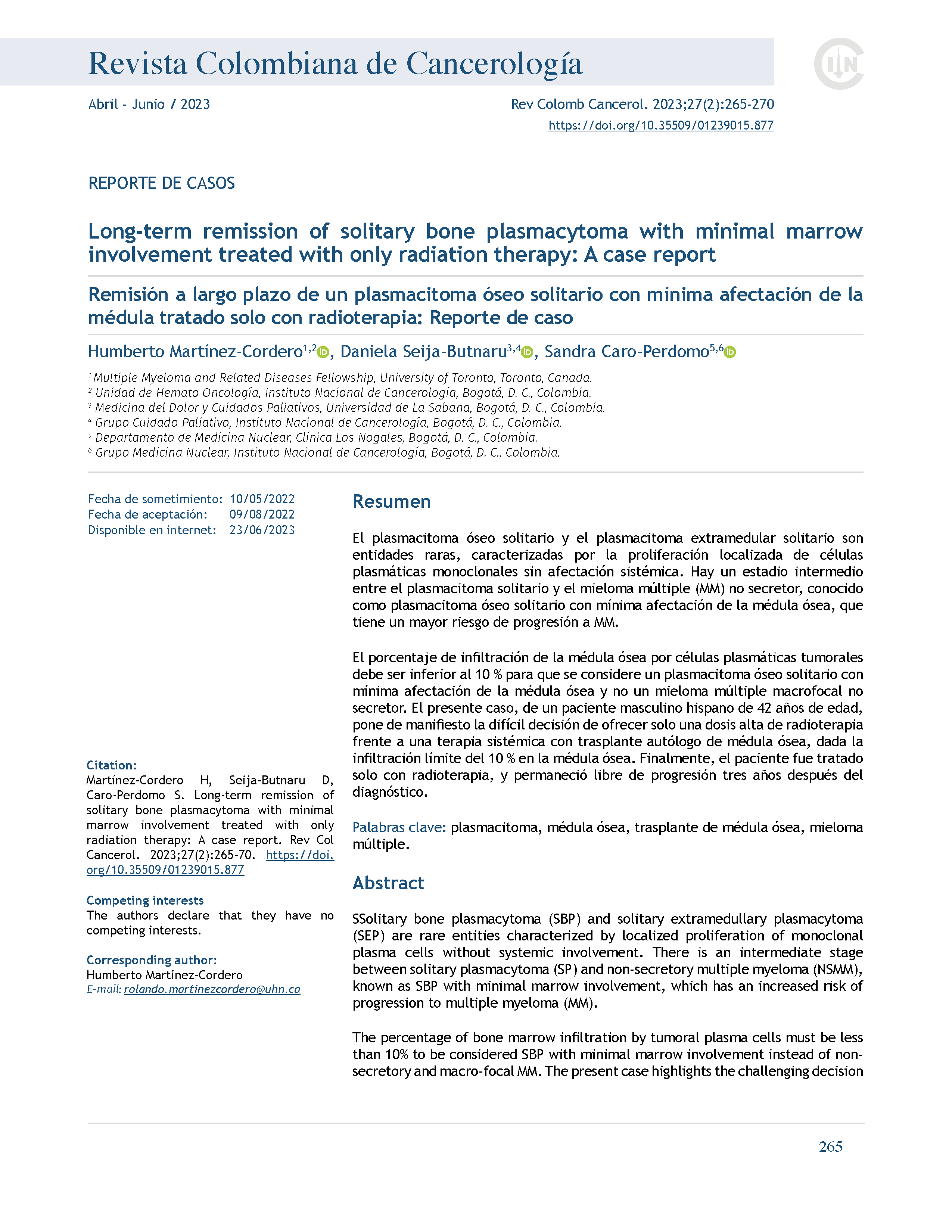Long-term remission of solitary bone plasmacytoma with minimal marrow involvement treated with only radiation therapy: A case report
DOI:
https://doi.org/10.35509/01239015.877Palabras clave:
English, plasmacytoma, bone marrow, bone marrow transplantation, multiple myelomaResumen
Solitary bone plasmacytoma (SBP) and solitary extramedullary plasmacytoma (SEP) are rare entities characterized by localized proliferation of monoclonal plasma cells without systemic involvement. There is an intermediate stage between solitary plasmacytoma (SP) and non-secretory multiple myeloma (NSMM), known as SBP with minimal marrow involvement, which has an increased risk of progression to multiple myeloma (MM).
The percentage of bone marrow infiltration by tumoral plasma cells must be less than 10% to be considered SBP with minimal marrow involvement instead of non-secretory and macro-focal MM. The present case highlights the challenging decision in a 42-year-old Hispanic male patient to offer only high-dose radiation therapy vs. systemic therapy with autologous bone marrow transplantation (ABMT), given the borderline infiltration of 10% in the bone marrow. Eventually, the patient was treated with only radiation therapy, remaining free of progression 3 years after diagnosis.
Biografía del autor/a
Humberto Martínez-Cordero, Multiple Myeloma and Related Diseases Fellowship, University of Toronto, Toronto, Canada.
1. Multiple Myeloma and Related Diseases Fellowship, University of Toronto, Toronto, Canada.
2. Unidad de Hemato Oncología, Instituto Nacional de Cancerología, Bogotá, D. C., Colombia.
Daniela Seija-Butnaru, Medicina del Dolor y Cuidados Paliativos, Universidad de La Sabana, Bogotá, D. C., Colombia.
3. Medicina del Dolor y Cuidados Paliativos, Universidad de La Sabana, Bogotá, D. C., Colombia.
4. Grupo Cuidado Paliativo, Instituto Nacional de Cancerología, Bogotá, D. C., Colombia.
Sandra Caro-Perdomo, Departamento de Medicina Nuclear, Clínica Los Nogales, Bogotá, D. C., Colombia.
5. Departamento de Medicina Nuclear, Clínica Los Nogales, Bogotá, D. C., Colombia.
6. Grupo Medicina Nuclear, Instituto Nacional de Cancerología, Bogotá, D. C., Colombia.
Referencias bibliográficas
Swerdlow SH, Campo E, Pileri SA, Harris NL, Stein H, Siebert R, et al. The 2016 revision of the World Health Organization classification of lymphoid neoplasms. Blood. 2016;127(20):2375-90. https://doi.org/10.1182/blood-2016-01-643569
Iqbal QUA, Majid HJ. Plasmacytoma. StatPearls. Accessed: May 14, 2023. Available from: https://www.ncbi.nlm.nih.gov/books/NBK573076/
Fotiou D, Dimopoulos MA, Kastritis E. How we manage patients with plasmacytomas. Curr Hematol Malig Rep. 2018;13(3):227-35. https://doi.org/10.1007/s11899-018-0452-z
Dimopoulos MA, Moulopoulos LA, Maniatis A, Alexanian R. Solitary plasmacytoma of bone and asymptomatic multiple myeloma. Blood. 2000;96(6):2037-44. PMID: 10979944
Warsame R, Gertz MA, Lacy MQ, Kyle RA, Buadi F, Dingli D, et al. Trends and outcomes of modern staging of solitary plasmacytoma of bone. Am J Hematol. 2012;87(7):647-51. https://doi.org/10.1002/ajh.23201
Pham A, Mahindra A. Solitary plasmacytoma: a review of diagnosis and management. Curr Hematol Malig Rep. 2019;14(2):63-9. https://doi.org/10.1007/s11899-019-00499-8
Dimopoulos MA, Moreau P, Terpos E, Mateos MV, Zweegman S, Cook G, et al. Multiple myeloma: EHA–ESMO Clinical Practice Guidelines for diagnosis, treatment and follow-up. Ann Oncol. 2021;32(3):309-22. https://doi.org/10.1016/j.annonc.2020.11.014
Khan AM. Guidelines for standardizing and increasing the transparency in the reporting of biomedical research. J Thorac Dis. 2017;9(8):2697-702. https://doi.org/10.21037/jtd.2017.07.30
PDQ Adult Treatment Editorial Board. Plasma Cell Neoplasms (Including Multiple Myeloma) Treatment (PDQ®). Accessed: May 10, 2023. Available from: https://www.ncbi.nlm.nih.gov/books/NBK65924/?report=classic
Reed V, Shah J, Medeiros LJ, Ha CS, Mazloom A, Weber DM, et al. Solitary plasmacytomas: outcome and prognostic factors after definitive radiation therapy. Cancer. 2011;117(19):4468-74. https://doi.org/10.1002/cncr.26031
Holland J, Trenkner DA, Wasserman TH, Fineberg B. Plasmacytoma. Treatment results and conversion to myeloma. Cancer. 1992;69(6):1513-7. https://doi.org/10.1002/1097-0142(19920315)69:6<1513::aid-cncr2820690633>3.0.co;2-x
Knobel D, Zouhair A, Tsang RW, Poortmans P, Belkacémi Y, Bolla M, et al. Prognostic factors in solitary plasmacytoma of the bone: a multicenter Rare Cancer Network study. BMC Cancer. 2006;6:118. https://doi.org/10.1186/1471-2407-6-118
Boll M, Parkins E, O’Connor SJM, Rawstron AC, Owen RG. Extramedullary plasmacytoma are characterized by a ‘myeloma-like’ immunophenotype and genotype and occult bone marrow involvement. Br J Haematol. 2010;151(5):525-7. https://doi.org/10.1111/j.1365-2141.2010.08386.x
Jung SH, Jo JC, Song GY, Ahn SY, Yang DH, Ahn JS, et al. Frontline therapy for newly diagnosed patients with multiple myeloma. Blood Res. 2020;55(S1):S37-S42. https://doi.org/10.5045/br.2020.S007
Cómo citar
Descargas

Descargas
Publicado
Número
Sección
Licencia
Derechos de autor 2023 Revista Colombiana de Cancerología

Esta obra está bajo una licencia internacional Creative Commons Atribución-NoComercial-SinDerivadas 4.0.
Todos los derechos reservados.




